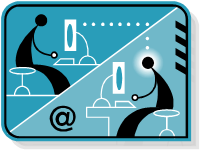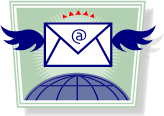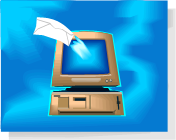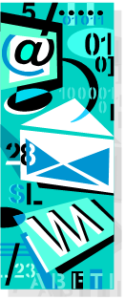Business Email Etiquette
By Helena Ferrari
[dropcaps type=”circle” color=”” background=””]D[/dropcaps]ue to the fast paced and ever changing global business environment, over 75% of people today rely heavily on electronic communication to conduct business. More than ever, customers have high expectations for speed and accuracy of requests and rely on effective email communications. This uncovers a new opportunity for businesses to standardize communication protocols on “email perception and etiquette” as a way to build and cultivate long-term customer loyalty and  increase customer satisfaction.
increase customer satisfaction.
Response Ready
The importance of follow-up on email whether to customer request or an internal employee is very important. Lack of follow-up can be frustrating to the sender as it may give the impression that they are not important or you are disorganized. In the following example, a company-wide email protocol would have been helpful.
A customer sent an email to a sales support representative to check the status of an order, waited two days, got no response, followed up with another email and still received no response. This company ended up losing this major customer who out of frustration took their business to a competitor.
In this example the company unfortunately learned a hard financial lesson and immediately put in place email protocols. Here are some examples:
• Prompt email communications within 24 hours of receipt.
• Follow-up reminders on a corporate calendar so everyone has access.
• Creation of two email accounts e.g.: a personal and sales support group so emails are shared with the entire support team.
• Automatic email responses that provide alternate contacts when you are not available to respond.
Email Etiquette
The importance of email etiquette training has proven to be valuable within organizations because when sending or replying to an email the recipient gets a perception of you and your company. A good training approach when corresponding with anyone via email is to imagine you are speaking with them on the telephone. The following list is a guide for training:
- Always start your email with “Hello”, “Hi”, or “Dear”, and their name, use whatever is appropriate based on your relationship with the recipient.
- A little chit-chat like asking them how they are? This helps build rapport before you get right to the point. You may think it is trivial or a waste of time for online correspondence however; this is a form of courtesy that you would use on the telephone and assists in making the recipient feel valued. When an email is straight to the point and direct without any greeting this could be perceived as cold and rude.
- The subject field should pertain to the information contained in email. Never send a blank subject line as it may be perceived as a spam, not important or accidentally get deleted.
- Remember email is not a Post-It note and should not be abbreviated. It should be created in the form of a proper business letter.
- Close your email with Kind Regards, Truly or Sincerely then followed by your name.
- Always provide a contact telephone number so the recipient has a record without having to look up the information.
Words Create Perception
There are some disadvantages of corresponding via email especially when it comes to expressing feelings or compassion. The reasons may be a high volume of work, a quick response is better than none, or it is hard to express feelings through writing. This can result in emails being short and to the point which may come across as cold or blunt. It really  helps to imagine you are having an actual conversation.
helps to imagine you are having an actual conversation.
Companies are now taking advantage of training on email tone and the quality of responses especially when it comes to customer service. Email can easily communicate the wrong impression. Therefore, a guide for training could focus on how the email response best serves the customer.
This type of training would have been helpful in the next scenario where the sender had the opportunity to apologize and acknowledge the inconvenience in order to make the customer feel valued and appreciated.
A customer sent the following email about an invoice for a previous order, “You have sent me three invoices for my previous order and I made the payment on the first invoice. Would you please look into the matter and adjust your records so I don’t receive another invoice?” The problem was finally solved but the email received was far from satisfactory from the customer’s perspective. The company wrote: “We have your payment.”
Answers Are Key
It is important to be sure that responses to requests actually answer the question. The following example may have happened if the website had an auto-response generated for any general inquiries, or if the email was not read properly.
A business traveler sent an email through a travel website requesting information for an upcoming business trip: “I’d like to book a hotel near the New York Convention Center, how can I find out which hotels are close and can I reserve the hotel on-line?” The response email explained how to make reservations online and referred them back to the website.
Check and Double Check
An unprofessional impression can be easily overcome by doing a check for grammar and spelling. This can be set up automatically in your email program but in addition it is suggested to proofread before sending as spell check does not always catch the following examples, “four” instead of “for,” or “your” instead of “you’re”.
Email Disclaimers
The majority of businesses do not store voice messages. Yet, most emails are kept, which further demonstrates the importance of the following information. A caution for business today is that written communication, including email, can be used to form binding legal contracts especially if the individuals have direct or indirect authority to do so. A suggestion for employees you do not wish to form binding contracts by email is to use an inclusion statement that can be added like “any form of contract needs to be confirmed by the individual’s manager”. Although a company is ultimately responsible for the actions of its employees, including the content of any emails sent, a disclaimer can decrease liability. Disclaimers convey a trustworthy image, and also deters any possible adversaries from litigation. It will also convey awareness and professionalism to your customers.
Please note that there are no disclaimers that protect against actual libelous or defamatory content. The most a disclaimer can accomplish is to reduce the responsibility of the company, since it can prove that the company has acted responsibly and has done everything in its power to stop employees from such acts.
Email today has become a serious business communication tool. Therefore, communication protocols and training are recommended as a top priority for retaining your existing customers and acquiring new customers.
Permission is needed from Lighthouse Consulting Services, LLC to reproduce any portion provided in this article. © 2014
Helena Ferrari, Director of Human Resources of SDC Technologies, Inc. has worked with many businesses globally throughout her career as a Human Resources professional.
If you would like additional information on this topic or others, please contact your Human Resources department or Lighthouse Consulting Services LLC, 3130 Wilshire Blvd., Suite 550, Santa Monica, CA 90403, (310) 453-6556, dana@lighthouseconsulting.com & our website: www.lighthouseconsulting.com.
Lighthouse Consulting Services, LLC provides a variety of services, including in-depth work style assessments for new hires & staff development, team building, interpersonal & communication training, career guidance & transition, conflict management, 360s, workshops, and executive & employee coaching. Other areas of expertise: Executive on boarding for success, leadership training for the 21st century, exploring global options for expanding your business, sales and customer service training and operational productivity improvement.
To order our books, “Cracking the Personality Code” and “Cracking the Business Code” please go to www.lighthouseconsulting.com.
